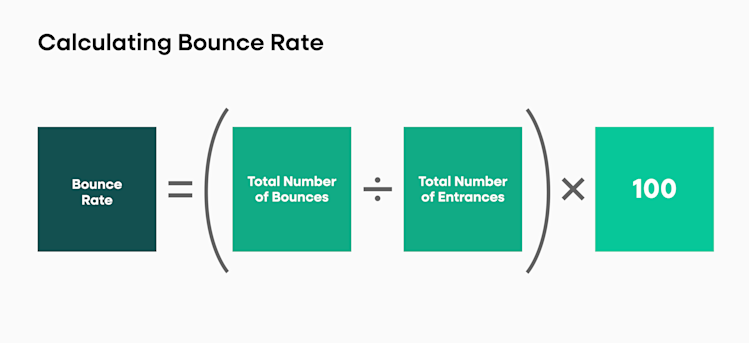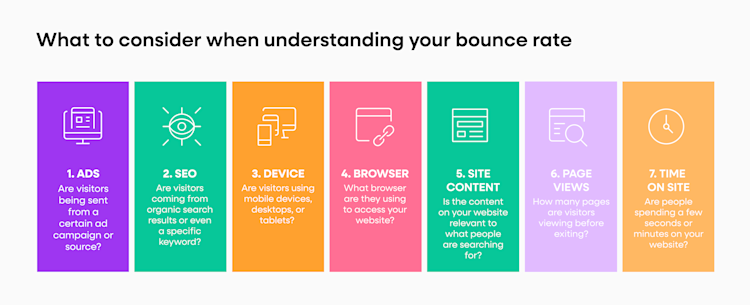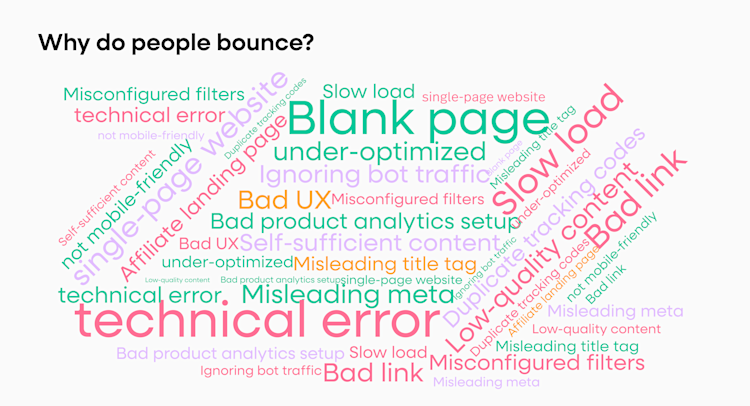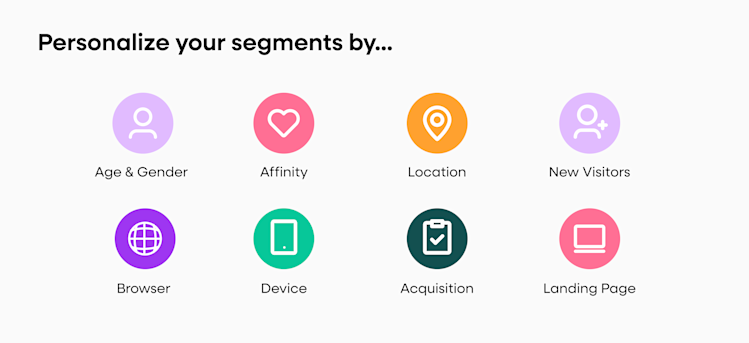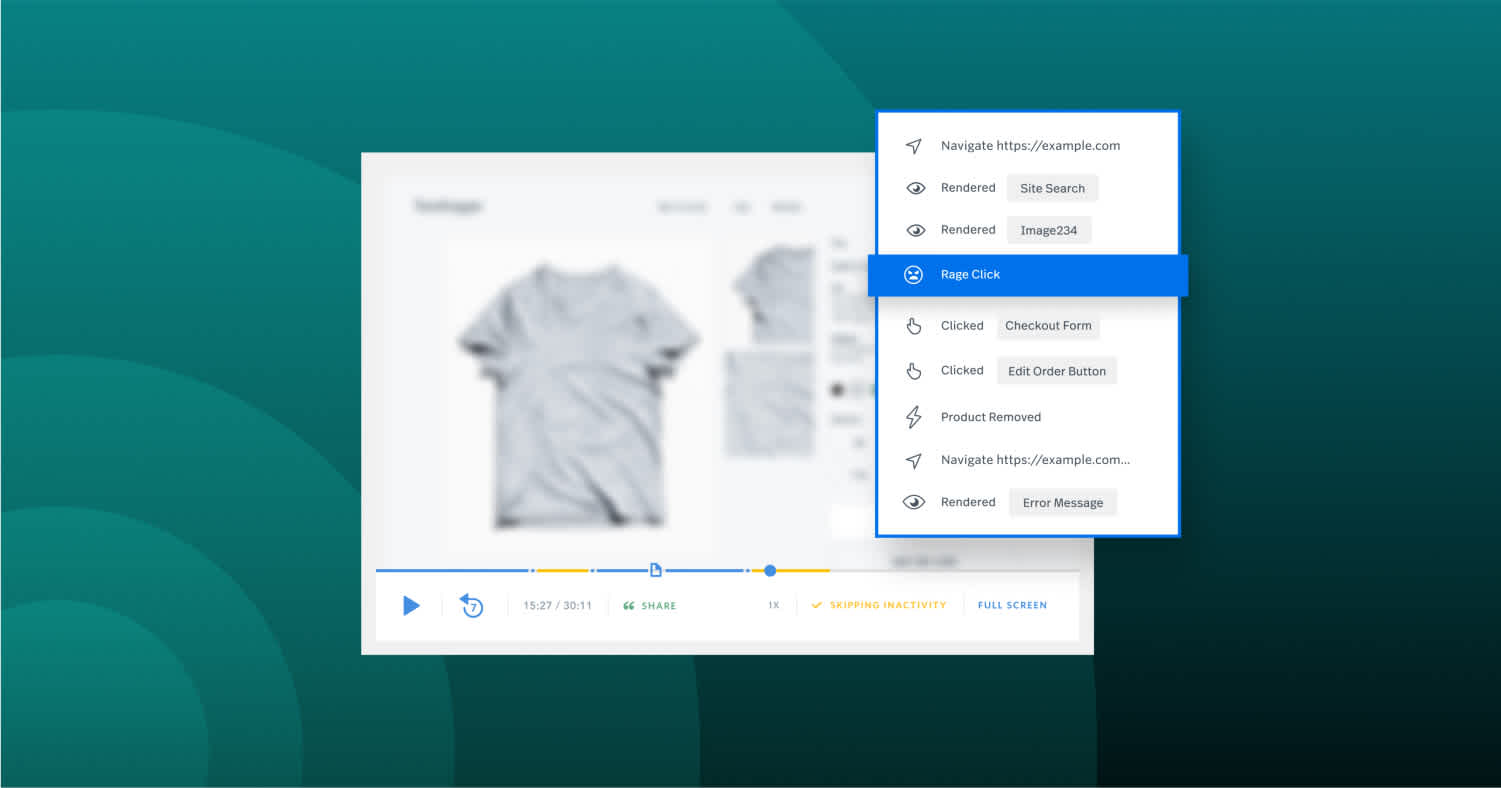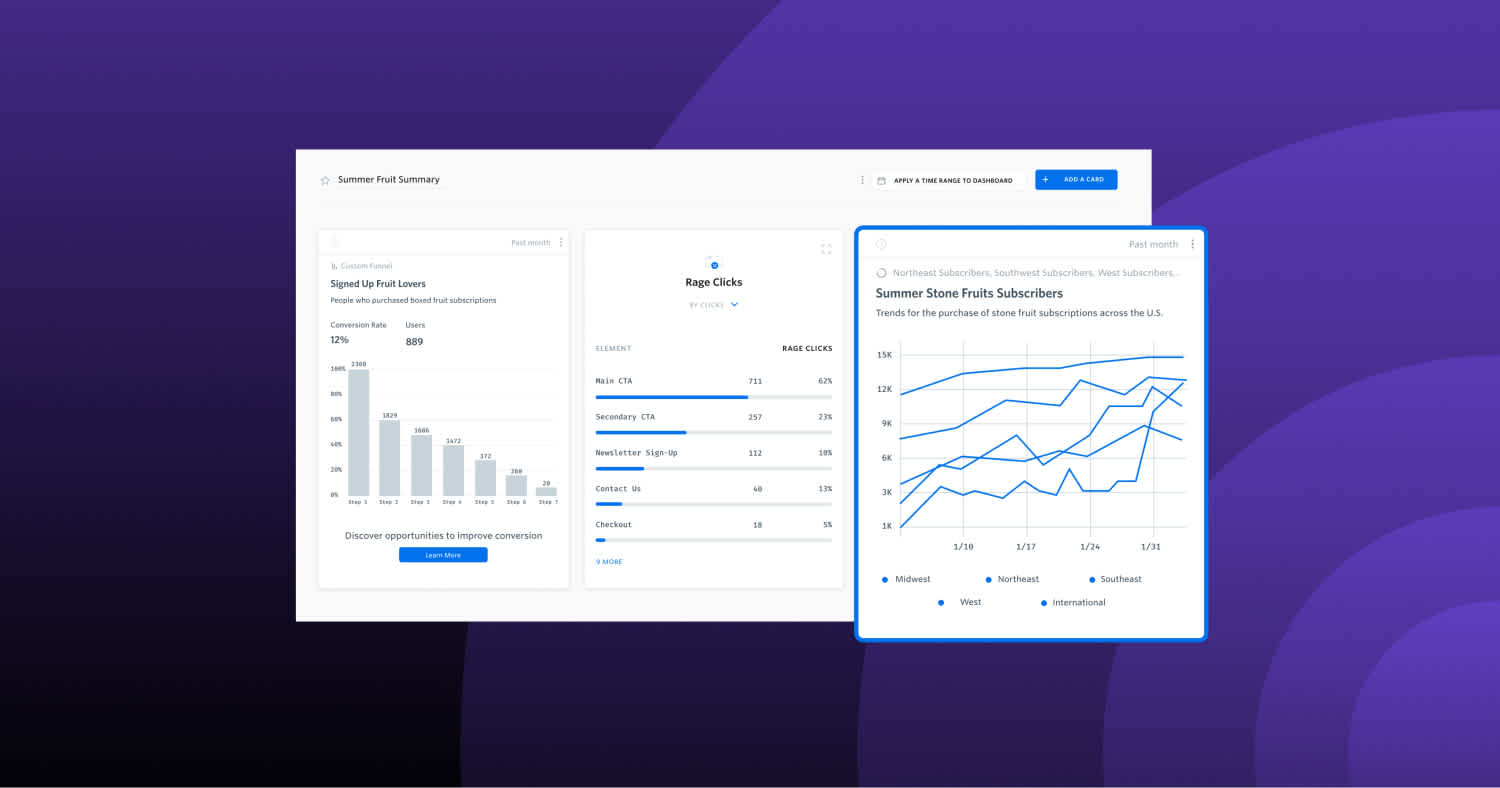Key takeaways
Bounce rate is one of the most commonly used website metrics
It's also an important website metrics, but never tells the whole story on its own
Your website strategy directly informs what your bounce rate could or should be
Different factors, like your content quality, load speeds, and more can impact your bounce rates
There is no one target bounce rate, and you instead focus on improving yours compared to your established baseline
What is bounce rate?
A bounce rate is a measure of how often visitors browse your site but then leave without clicking on another page. It’s one of the most important metrics when it comes to understanding user behavior and improving overall engagement with your website.
If your bounce rate is high, it could indicate that something on your site isn’t quite working. Assessing your website’s health can help pinpoint whether technical issues or content misalignment are driving users away.
It might also mean that your website content is not relevant to what visitors are looking for. In either case, reducing the bounce rate should be a priority if you want to keep visitors engaged and support effective conversion rate optimization.
You want to determine how to break down your “target” bounce rate, which can help you understand exactly what’s happening.
Bounce rate formula
The formula for calculating your bounce rate is fairly simple. It’s the percentage of visitors that land on a single page and then leave without viewing any other pages. The bounce rate formula is:
Bounce rate = (Total number of visitors who leave after viewing only one page / Total number of visitors) x 100%
For example, if a website receives 1000 visitors in a day, and out of these visitors, 400 visitors leave the website after viewing only one page, then the bounce rate would be:
Bounce rate = (400 / 1000) x 100% = 40%
This means that 40% of the visitors who land on the website leave after only viewing one page. A high bounce rate may indicate that the website is not engaging enough for visitors or the visitors are not finding what they are looking for on the website.
Bounce rate vs. exit rate
Bounce rate and exit rate are both website analytics metrics used to measure visitor behavior, but they don’t measure the same things.
Bounce rate measures the proportion of people who leave after viewing just one page. These visitors did not interact with any other pages on the website, and they did not stay on the website for very long. Bounce rate is often used as an indicator of the website’s user experience and how engaging the content is for visitors.
Exit rate, on the other hand, measures those who leave from a particular page. Unlike bounce rate, these visitors may have interacted with other pages on the website before leaving. Exit rate is often used to identify specific pages or areas of the website that are causing visitors to leave.
To illustrate the difference between these metrics, imagine a visitor lands on a website’s homepage and clicks through to the “About Us” page. If the visitor leaves the website after viewing only the “About Us” page, this would be counted as a bounce.
However, if the visitor goes on to view the “Contact Us” page and then leaves the website, this would be counted as an exit from the “Contact Us” page.
What is a good bounce rate?
The average percentage for a good bounce rate can vary based on what industry you’re in. Tools like Google Analytics and Fullstory provide an easy digital benchmarks to help compare your website performance to others in the same industry. Generally speaking, however, the average is around 58.18%.
That said, it’s important not to obsess over a high or low bounce rate and instead use them as a starting point to identify weaknesses in your website and how visitors interact with it.
What's a good bounce rate for you?
Different types of websites average different bounce rates. Learn more about what you should be targeting.
Finding your target bounce rate
When looking at your website’s bounce rate, you want to determine how to break down your “target” bounce rate, which can help you understand exactly what’s happening. This involves taking into consideration the following factors:
Ads: Are visitors being sent from a certain ad campaign or source?
SEO: Are visitors coming from organic search engine results or even a specific keyword?
Device: Are visitors using mobile devices, desktops, or tablets?
Browser: What browser are they using to access your website?
Site content: Is the content on your website relevant to what people are searching for?
Page views: How many pages are visitors viewing before exiting?
Time on site: Are people spending a few seconds or minutes on your website?
Once you’ve taken these factors into account, you can begin to identify areas that need to be improved in order to reduce your bounce rate and keep visitors engaged.
How bad is a high bounce rate?
A high bounce rate can indicate that visitors are not finding what they are looking for on a website or that the website’s content or user experience is not engaging enough. However, whether a high bounce rate is “bad” or not depends on the context and the website’s goals.
For example, if a website is designed to provide quick answers to specific questions, like a recipe website, a high overall bounce rate may not necessarily be bad. Visitors may find the recipe they are looking for on the first page and then leave the website without needing to explore further. In a way, a high bounce rate is good—you provided the exact information the user needed.
On the other hand, if a website is designed to provide in-depth information or sell products, a high bounce rate may indicate a problem. It could mean that visitors are not finding the information or products they are looking for, or that the website is not engaging enough to keep visitors interested and exploring.
When is a high bounce rate good?
While a high bounce rate is generally not desirable, there are some scenarios where a high bounce rate can be considered good or acceptable.
Single-page websites
If a website is designed to have only one page, such as a landing page, then a high bounce rate is to be expected. In this case, visitors are directed to take a single action and leave the website, so a single-page visit and high bounce rate is not necessarily a bad thing.
Informational websites
Websites that provide quick answers to specific questions, such as a weather website or a calculator website, may have high bounce rates as visitors quickly find the information they need and then leave the website.
Mobile traffic
Visitors who come to a website from a mobile device may have a higher bounce rate because they are more likely to be looking for quick information on the go.
Seasonal websites
Websites that are only relevant during a specific time of year, such as a Christmas gift guide website or a Halloween costume website, may have high bounce rates during the off-season when visitors are not interested in the content.
Affiliate marketing websites
Websites that make money through affiliate marketing may have high bounce rates because visitors are directed to other websites to make a purchase.
There are instances where a high bounce rate is OK. However, in most cases, a high bounce rate should be monitored and analyzed to identify potential issues with the website’s content or user experience.
Why do people bounce?
If you’re scratching your head over why visitors are bouncing from your page, it might not be as mysterious as you think. There are many factors that can come into play and affect your bounce rate, including:
Slow-to-load pages
Slow-loading pages are a thing of the past for high-ranking websites. A big part of why has to do with Google focusing on fast site speed. Websites that don’t load quickly are detected by the algorithm and thus relegated to later page results. What’s more, most visitors won’t even bother to stick around waiting for a page to load in the modern era.
You’ve likely also noticed that Google’s been promoting snippets as of late in its search results. That’s because users want to get their information fast and be able to quickly click away from a website if it doesn’t deliver.
Make sure you are using tools like Google PageSpeed Insights or Pingdom Website Speed Test to review your page speed, both overall and for individual pages. If there is an issue with the loading time, you can use various techniques to speed up your website and ensure visitors stay longer.
See what's slowing down your website and fix it today
With Fullstory, you’ll get the most comprehensive analysis of your website speed with easy reports on your First Contentful Paint (FCP), Largest Contentful Paint (LCP), DOMContentLoaded (DCL), and more. That way, you’ll easily know where your problems lie and how to fix them.
Get Fullstory’s analytics onto your website—for free—for two weeks.
Self-sufficient content
Another reason why visitors might bounce from a website is due to self-sufficient content. Visitors may quickly leave a website if they find the content irrelevant or not informative enough.
This could happen if the website’s content is poorly written, outdated, or does not meet the visitors’ expectations. To ensure that the website’s content is self-sufficient, it is essential to identify the target audience and create content that meets their needs and preferences.
Disproportionate contribution by a few pages
Sometimes, a few pages on your website can contribute disproportionately to the bounce rate overall. If this is the case, it’s important to take a look at these pages and see if they actually satisfy user intent or could be improved in some way.
For example, single CTA landing pages that quickly move visitors onto another page may lead to higher bounce rates, but that doesn’t necessarily mean you should remove them.
However, if long-form content has lower bounce rates, it’s likely worth digging into and analyzing why this is the case so you can apply these techniques elsewhere on the website.
Misleading title tag and/or meta description
It’s also possible that visitors are clicking on your website, expecting to find something different than what they get. There’s always a possibility that Google will make changes to your meta. If this happens, you can’t automatically assume that it will be for the betterment of your website. So make sure you keep a watchful eye and take steps to remedy any potential issues.
Blank page or technical error
Even more frustrating than misleading titles and descriptions is when a website has a blank page or some kind of technical error. This might make Google drop pages from the search results in a hurry, so make sure you’re always checking your website to fix potential issues.
By keeping an eye on these factors, you can start to make progress in improving your bounce rate and ensuring visitors stay engaged with your website.
Bad link from another website
Look for any external sources that are linking to your website. If you find that a link from another website is sending visitors away rather than engaging them, it might be time to dig in and figure out what’s going on.
If the article links to yours with unrelated or spammy keywords, you can use Google’s disavow file and get rid of any links that could be lowering your ranking. Only do this if you are certain you should, as accidentally disavowing good links can adversely impact your search engine rankings.
On the other hand, if the website seems to be intentionally trying to harm your website with negative SEO tactics, it might be best to contact the webmaster or author of the article directly and ask them to remove the link.
Once you take all of these factors into account, you can begin to identify areas that need to be improved in order to reduce your bounce rate and keep visitors engaged. As long as you stay vigilant about monitoring any potential problems and making changes accordingly, you should see an overall improvement in your website’s performance.
Affiliate landing page or single-page website
Generally, a high bounce rate on a single-page site or affiliate landing page isn’t necessarily a bad thing. After all, the purpose of these pages is to quickly move visitors along to another page or website.
Still, if you find that your bounce rate for such pages is particularly high (over 75%), it might be time to check the page to make sure it’s effective in directing visitors where you want them to go.
Low-quality or under-optimized content
It’s also worth considering if your content is of sufficient quality or optimized in the right way to meet visitor expectations. If it’s not, visitors may be bouncing off quickly due to being disappointed by what they find on your page.
In this case, you may need to look into hiring a freelance copywriter or creating more content related to the topic, so visitors stay longer and take some kind of action on your website.
This can be anything, ranging from blog posts to your homepage. Think about it: if a visitor arrives on your site, and your content doesn't answer what they're looking for, they're simply going to hit the back button.
Bad or obnoxious UX
It’s equally important to consider how bad or obnoxious user experience can contribute to a higher bounce rate. This can come in various forms such as bombarding visitors with ads and pop-up surveys, or simply bad design of the website.
It’s imperative to evaluate and critique the user interface (UI) and user experience (UX) of your site. This might be worth taking some time on, as it can make a huge difference in terms of keeping visitors engaged with your content and reducing bounce rate.
Seeing as how UX and UI design can be an intensive process, it’s worth considering hiring a web or UX designer to review your site and make the necessary improvements.
This way you'll more easily avoid user friction single-page sessions.
A web page isn’t mobile-friendly
Virtually everyone uses a mobile device today, so it’s important to make sure your website is optimized for all devices. If your website isn’t mobile-friendly, chances are you’re going to have a high bounce rate due to visitors not being able to access or navigate the page properly.
Back in 2019, Google switched to a mobile-first indexing, which means that the mobile version of your website is its main ranking factor—it's what Google crawls first and takes into account when ranking websites. This is important for all types of websites, from ecommerce sites to media sites. So if you’re seeing a high bounce rate and no glaring issues, it might be worth testing it on your mobile phone.
A quality behavioral data platform like Fullstory, so you can analyze your users’ mobile sessions, is critical.
Bad product analytics setup
If your product analytics setup is broken, it can lead to inaccurate data and misinterpretation of website performance. This is also important if you use simple analytics like Google Analytics.
Here are some common issues that can cause a wonky analytics setup:
Incorrect tracking code implementation: If the tracking code is not implemented correctly on all pages of the website, analytics may not track all visitor data accurately.
Duplicate tracking codes: Multiple tracking codes on the same page can lead to double-counting of visitors and other metrics.
Misconfigured filters: Incorrectly configured filters can exclude or include certain data, leading to incomplete or inaccurate information.
Cross-domain tracking issues: If the website uses multiple domains or subdomains, cross-domain tracking may be necessary to track visitor behavior accurately.
Ignoring bot traffic: Bot traffic can skew data and misrepresent website performance if it is not excluded from the analytics data.
Time zone and currency settings: If the time zone and currency settings are not correctly set, it can lead to inaccurate reporting of data.
Regularly monitoring and reviewing the analytics data can also help identify any issues and ensure that the website’s performance is accurately tracked.
Content depth
Google’s algorithms can give people quick answers through featured snippets and knowledge panels. However, that doesn’t mean you should focus exclusively on short-form content. You should also provide deep, interesting, interconnected content that’s a step beyond what Google is providing in its search results.
Asking for too much
One of the biggest contributors to a high bounce rate is having too many forms or asking for too much information right away. If it takes more than a couple of seconds for visitors to complete a task or fill out a form, chances are they’ll click away and go somewhere else.
How to reduce your bounce rate
Make sure your content lives up to the hype
Remember: content is king. Making sure your content lives up to the hype is crucial to reducing bounce rate and improving user engagement on your website. When users are enticed by your headline or call-to-action, they expect the content to deliver on its promise.
Keep critical elements above the fold
“Above the fold” refers to the area of a website that is visible to the user without scrolling down. This area is prime real estate, as it is the first thing that users see when they visit your website.
Use heatmap software and session replay software together to see what your users are engaging with so you know what interests them. Combining this type of qualitative data with quantitative data is especially important for understanding what your users care about most.
Speed up your site
A slow website can lead to visitors leaving quickly. Make sure your website loads quickly and optimizes images, videos, and other content.
Minimize non-essential elements
Minimizing non-essential elements on a website is an effective way to improve the user experience and reduce bounce rate. Non-essential elements include anything that doesn’t directly contribute to the user’s goals or objectives on the site, such as unnecessary text, images, or features.
Help people get where they want to be faster
Helping people get where they want to be faster on your website is an effective way to improve the user experience and reduce bounce rate. Users want to find what they need quickly and easily, so it’s important to design your website with their needs in mind.
Fix your bounce rate today
Find the problems with your website and fix them quickly. Start a free 14-day trial with Fullstory today— no strings attached.
Understanding bounce rate by demographics and psychographics
Segmenting users with user analytics programs is crucial. In fact, many site teams benchmark their bounce rates for each user segment, separating rates for different groups.
Segment bounce rate by age
Segmenting bounce rate data by age can help website owners understand how different age groups engage with their website. This information can be used to tailor content and user experience to specific age groups and improve engagement.
Segment bounce rate by gender
By segmenting bounce rate data by gender, website owners can gain invaluable insight into how male and female users interact with their site. Utilizing this knowledge helps them to tailor the content and user experience for each gender, ultimately leading to improved engagement rates.
Segment bounce rate by affinity
By segmenting bounce rate data according to affinity, website owners can gain an improved understanding of how different user groups interact with their site. This insight can then be used to craft content and experiences that are specifically tailored for certain affinity groups and thus boost engagement.
Segment bounce rate by location
Harnessing data on bounce rate by location can be a valuable tool for website owners, enabling them to see how viewers from different geographic areas interact with their site.
Segment bounce rate by new visitors
It’s also a good idea to segment bounce rate by new visitors or new page visits. This will help you get an understanding of how they interact differently with your website.
Segment bounce rate by browser
Different browsers may render your website differently, leading to different user experiences. Evaluate if your site is configured well for that browser and if the traffic from that browser is bringing you any value.
Segment bounce rate by device
In order to get the most out of your website, you should also segment bounce rate by device—mobile, desktop, iPad, etc.
This will give you an overview of how different devices access and interact with your website, enabling you to make informed decisions on how to improve your website design and layout.
Segment bounce rate by acquisition
The same goes for returning visitors. It’s important to understand how they interact differently with your website and which pages have the highest bounce rates.
For example, if you’re running a promotion or advertising campaign, you can use this data to determine whether it was effective or not. If the bounce rate is high from these sources, you’ll know that you need to take a closer look at your ad targeting or website content.
Segment bounce rate by landing page
A great way to understand the bounce rate on any page is by segmenting it by landing page.
You may find that one page has a much higher bounce rate than the others. If this is the case, it could be worth your while to visit the page and look for any design issues or problems that might be causing visitors to leave.

